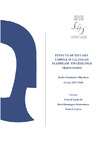Please use this identifier to cite or link to this item:
https://accedacris.ulpgc.es/jspui/handle/10553/73651
| Title: | Effects of dietary copper in gilthead seabream fingerlings (Sparus aurata) | Authors: | Sarmiento Mendoza, Paula | Director: | Izquierdo López, María Soledad Domínguez Montesdeoca, David Castro Alonso, Pedro Luis |
UNESCO Clasification: | 251092 Acuicultura marina | Keywords: | Aquaculture Gilthead seabream Cu Micronutrient Diet, et al |
Issue Date: | 2018 | Project: | Consumer driven Production: Integrating Innovative Approaches for Competitive and Sustainable Performance across the Mediterranean Aquaculture Value Chain | Abstract: | Gilthead seabream (Sparus aurata) is the third most produced fish in aquaculture of EU. In commercial feeds for this species, marine ingredients (fish meal (FM) and fish oil (FO)) are being increasingly substituted with ingredients of terrestrial origin with different mineral profiles. Copper (Cu) is an essential trace element necessary for the correct functioning of numerous Cu-dependent enzymes. Fish can uptake Cu from the water or diet, and it is particularly accumulated in eyes, liver, heart and brain. Besides, high concentrations of Cu may exert toxic effects. In general, ingredients of terrestrial origin have higher Cu levels than marine ingredients. With the changing ingredient profile of commercial aquafeeds, it is necessary to define the optimal dietary supply of Cu to ensure better performance, and to avoid excess supplementation. Thus, the aim of this study was to evaluate optimal dietary inclusion level of Cu in low FM-FO diets for gilthead seabream fingerlings. A basal diet closely mirroring practical seabream feeds was formulated with low inclusion of FM (10%) and FO (6%). Five vegetable-based diets contained a mineral premix of CuSO4 in five different concentrations at 6, 7, 9, 13 and 35 mg Cu/kg diet were fed to seabream fingerlings (12.6 ± 1.4 g, mean ± SD). Fish were distributed in 15 tanks with 30 fish per tank and randomly assigned one of the dietary treatments, in triplicates. The fish were fed three times a day until apparent visual satiation for 42 days. The lowest dietary Cu levels tested (6 mg Cu/kg) did not caused low growth or other signs of Cu deficiency. Therefore, the lowest dietary Cu levels tested in this study were not enough to observe clear Cu deficiency symptoms and this level would be enough to meet the needs for correct growth of seabream fingerlings. Nevertheless, dietary increase from 6 to 9 mg Cu/kg, lead to a generalized increase in n-3 HUFA and slight improvements in productive parameters such as weight gain, feed efficiency, specific growth rate and thermal growth coefficient, as well as an up-regulation of cat gene expression. These results suggest that a maximum inclusion of 9 mg Cu/kg would be recommended to maximize n-3 HUFA deposition in seabream. Moreover, increase in dietary Cu levels over 9 mg/kg Cu led to reduction in HUFA levels, down-regulation of cat expression and, most importantly, an increase in liver damage. The hepatocyte damage could be seen in the histological results through an increase of steatosis, peripheral nucleus, break of the cellular margin and the dilatation of sinusoids. All these effects denote clear symptoms of a Cu excess in seabream fingerlings when dietary Cu is raised over 9 mg/kg Cu. | Department: | Departamento de Biología | Faculty: | Facultad de Ciencias del Mar | Degree: | Grado en Ciencias del Mar | URI: | https://accedacris.ulpgc.es/handle/10553/73651 |
| Appears in Collections: | Trabajo final de grado |
En el caso de que no encuentre el documento puede ser debido a que el centro o las/os autoras/es no autorizan su publicación. Si tiene verdadero interés en el contenido del mismo, puede dirigirse al director/a o directores/as del trabajo cuyos datos encontrará más arriba.
Show full item recordItems in accedaCRIS are protected by copyright, with all rights reserved, unless otherwise indicated.
